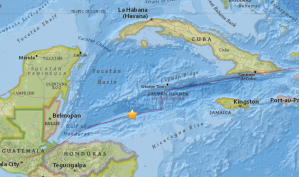There is no longer a tsunami threat for the Caribbean and Central America after a magnitude-7.6 earthquake struck 27 miles (43 kilometers) off the coast of Honduras, the US Pacific Tsunami Warning Center said Wednesday.

Waves reaching 0.3 to 1 meter above the tide level had been possible, but the agency said the threat had passed.
The earthquake struck east of Great Swan Island, Honduras, at the relatively shallow depth of 10 kilometers, the US Geological Survey (USGS) said.
Juan Jose Reyes, Director of Early Warning Systems of the Honduran disaster prevention agency COPECO, had urged people from low-lying coastal areas, especially the small offshore Islas de la Bahía islands to seek refuge, particularly if the tide suddenly is drawn out — a telltale sign that a tsunami is imminent.
“If you notice that the (sea) disappears, you have to go to (a) high place,” he said at a briefing with reporters in the capital Tegucigalpa.
“Pay attention to the alerts, to the authorities.” He said the warning was not intended to increase panic but rather “to inform (people) objectively so that measures can be taken.”
‘Check on family members’
What appeared to be the periodic wail of a tsunami warning system was heard throughout a 10-minute a video posted to Facebook by Edison Usher. In the clip, Usher says he was standing near a taxi stand less than 200 meters from the shore in Belize City.
“Check on your family members that live close to the sea,” he says during the video. “Don’t take nothing for granted.”
Other residents of the Belizian city were evacuating to inland areas in case the tsunami hit, Silvino Riverol, a resident of the inland town of Orange Walk told CNN.
“They going to Belmopan City towards the west which is high elevation and inland. I went to try to get video of the sea but the Police stopped me from going farther into the city.”
He said that his area was not at risk but others had been advised to evacuate their homes.
“I live in Orange Walk Town so we are safe and away from the coast. It’s mostly the folks from (Belize City) and southern coastal towns that are being told to evacuate by NEMO (the National Emergency Management Organization).
“My family from the city say the sea seems to be drying up. So I’m guessing that the water will return.”
Tsunamis can travel over 800 kilometers per hour (500 miles) at the deepest point of the water, but they slow as they near the shore, eventually hitting the shore at around 30 to 50 kph (20 to 30 mph). The energy of the wave’s speed is transferred to height and sheer force as it nears shore.
In recent years, tsunamis have been responsible for significant numbers of deaths and environmental destruction.











